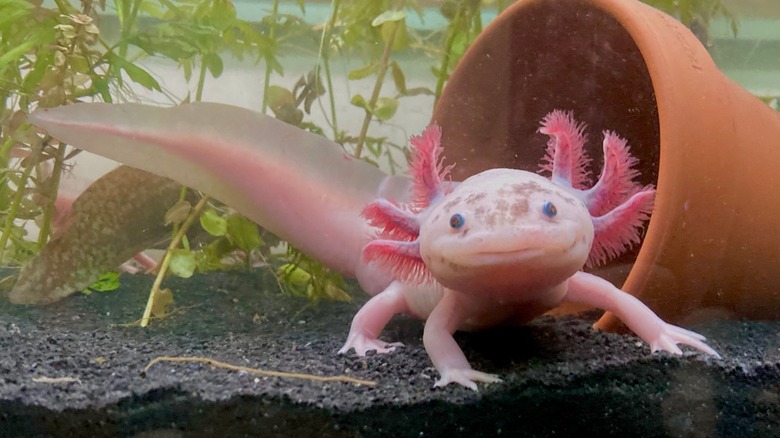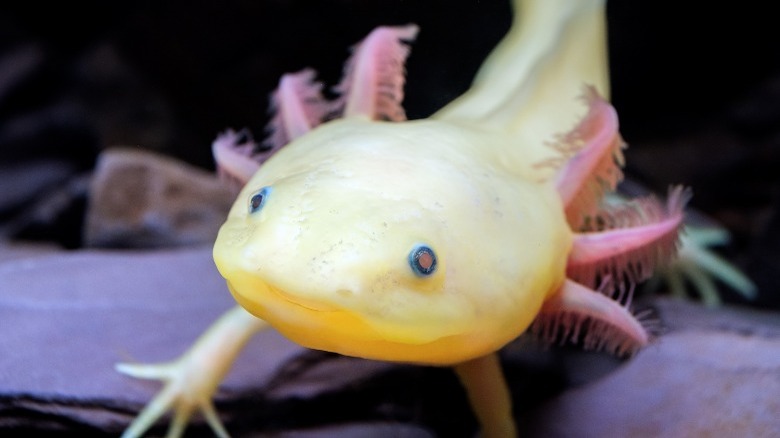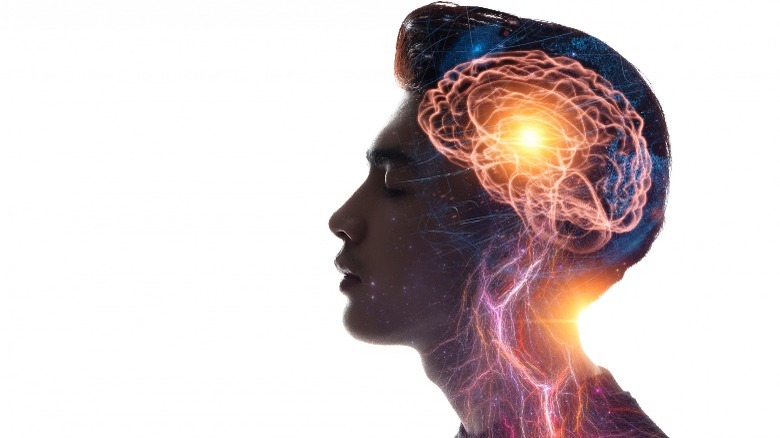This Adorable Aquatic Creature Has A Truly Bizarre Ability
Visit Mexico City today, and you'll only see scant remnants of two freshwater lakes that once existed there: Lake Xochimilco and Lake Chalco. You also won't find very many axolotls, a type of salamander native to these lakes. Whereas axolotls are now considered endangered, many are bred in captivity each year because they are used in scientific studies (via Axolotl).
What makes the axolotl so interesting to study? Primarily its ability to regenerate lost body tissue. According to The Conversation, axolotls can regenerate their spinal cord, heart, limbs, and most amazingly, their brains. Regenerated body parts in axolotls are not made of scar tissue, as they are for most animals, but are more similar to the part originally lost (via Axolotl).
Axolotls are amphibians, which are seemingly very different from mammals, but in fact, axolotls have similar coding genes to humans. This may mean that humans have regeneration-related genes as well, but can't activate them (via South China Morning Post). Some recent studies have looked at brain regeneration in axolotls in hopes of eventually applying the findings to humans.
Findings of the studies
A quartet of Chinese scientific and academic organizations conducted a study this year that showed axolotls' brains can fully recover from injury in about 60 days. Within only 15 days, the axolotl had developed new cells called ependymoglials that went from dormant to reactive and developed quickly. 20-30 days after a brain injury, the axolotl had regenerated new tissue that was different from that in uninjured parts of the brain, but by the 60-day mark, the injured and uninjured parts of the brain were once again the same (via South China Morning Post).
Also this year, a study conducted by scientific labs in Zurich and Vienna tried to determine if axolotls can regenerate all different types of brain cells. They did this through single-cell RNA sequencing, a process of counting how many genes are active within one brain cell, according to The Conversation. They took samples from the telencephalon of axolotls. In humans, this is the largest part of the brain and contains the neocortex, which controls behavior and cognition. The researchers looked at neurons and progenitor cells in the axolotls' telencephalon; the latter can divide and turn into another type of cell. When axolotl progenitor cells became neurons, they passed through a mid-stage called a neuroblast. This had not been observed before in axolotls. Observing the animals for 12 weeks, scientists determined that all different types of brain cells that had been lost were regenerated and that neuronal connections between different parts of the brain had been restored post-injury.
Implications of the studies' findings
These institutions in China and Europe conducted their studies with the hope that in the future, stem cells could be introduced to human brains in order to activate regeneration genes. The European team noted that axolotls have similar hippocampus and olfactory cortices as humans. These are the parts of the brain controlling memory formation and sense of smell, respectively. The axolotls' cells regulating perception, thought, and spatial reasoning are especially similar to humans'. This means these parts of the brain didn't change drastically because of evolution, and amphibian brains may contain a cell type that's an "ancestor" to mammalian brain cells (via The Conversation).
Both teams plan to look further into what initiates and controls the axolotl's regeneration, such as proteins bound to their DNA. They may also study mice in the future. It will be a while, however, according to the South China Morning Post, before any of this can be tested on humans.


